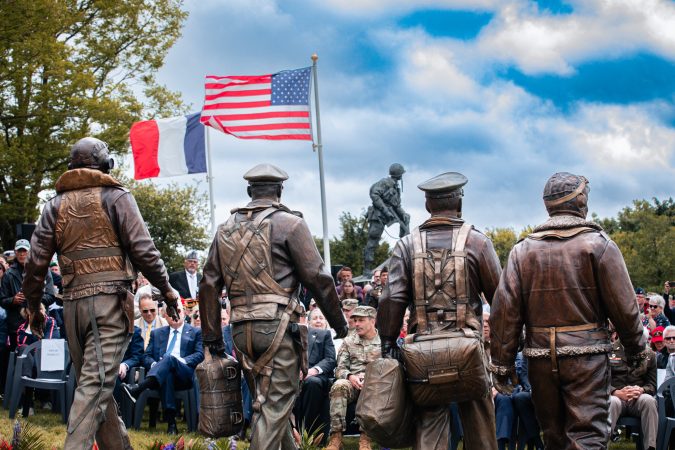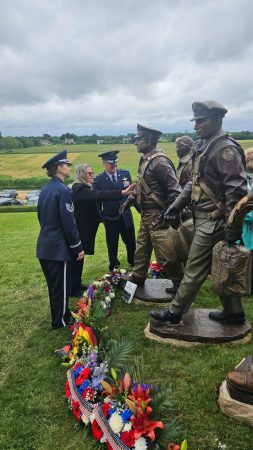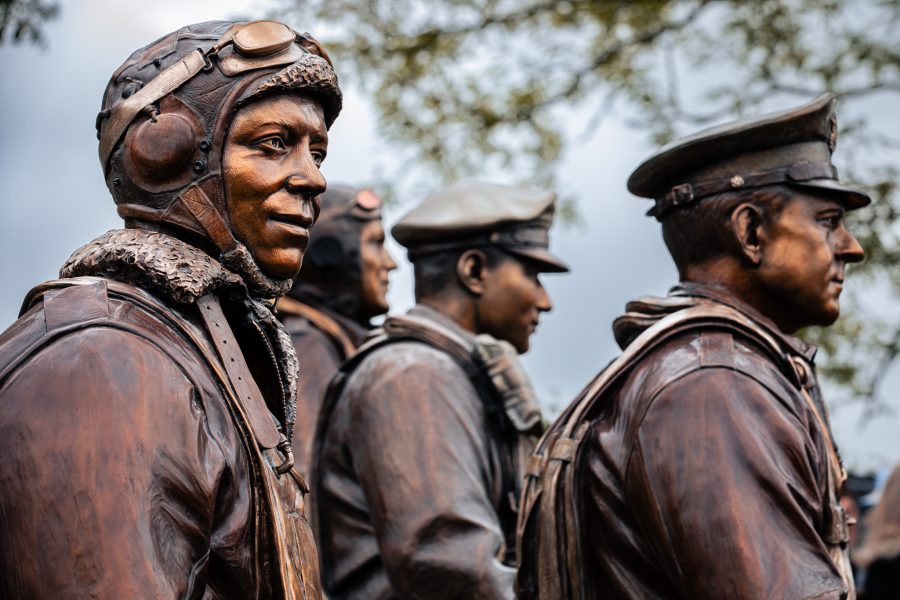For nearly a century, the Normandy battlefield has been a place to honor the brave Soldiers who stormed Fortress Europe on June 6, 1944. But in all those years, nothing has stood to memorialize the Airmen of the Eighth Air Force who were charged with destroying the German Luftwaffe to clear the way for the invasion force—until now.
A new Eighth Air Force Memorial, tucked behind the D-Day landing beaches, immortalizes those Airmen in bronze 81 years after they defeated the Nazi air force, suffering tens of thousands of combat deaths along the way.
“This was so long overdue,” said T. Michael “Buzz” Moseley, a former Air Force chief of staff who helped bring the memorial to fruition. “Can you imagine being a squadron commander in one of those bomb groups?”

As Allied forces planned Operation Overlord in late 1943—their invasion of German-occupied France during World War II—U.S. Airmen took on a no-fail mission. Operation Pointblank sought to take control of Nazi airspace, as well as to weaken Germany’s fighter fleet and its manufacturing base, to give D-Day a better chance of success.
For Operation Overlord planners, “there’s a reality of, you’re not going to get across the [English] Channel, and you’re not going to cross that beach if the Luftwaffe is intact,” Moseley said.
Moseley partnered with Ross Perot Jr., son of the American billionaire and two-time presidential candidate, and Dorothea de La Houssaye, founder and chairman of the Normandy Institute, to get the memorial project off the ground in 2023.
The time was right: Production had started on the Apple TV+ miniseries “Masters of the Air,” infusing momentum into the memorial effort. The series, based on Don Miller’s bestselling book of the same name, brought to light Eighth Air Force’s sacrifices during the war.
Over the course of World War II, the “Mighty Eighth” became the largest fleet of fighter and bomber aircraft in the world, according to the Air Force. It could launch more than 2,000 bombers and 1,000 fighters on a single mission, and flew more than 600,000 sorties and dropped more than 670,000 tons of bombs by the end of the European campaign in May 1945.
Eighth Air Force suffered 26,000 fatalities during World War II; another 28,000 of its Airmen were prisoners of war, the Air Force said. The organization earned 17 Medals of Honor, 220 Distinguished Service Crosses, and more than 420,000 Air Medals.
“People really don’t understand the contributions that Airmen made in World War II,” Moseley said.
Part of Operation Pointblank intended to destroy the Nazi aircraft production industry. One of the operation’s deadliest raids occurred on Oct. 14, 1943, when B-17 bombers from the Eighth targeted the precision-bearings plant in the German city of Schweinfurt.
Of the 291 bombers that flew the mission, 60 were shot down, resulting in roughly 600 Airmen lost over enemy territory, according to Air Force casualty figures. The date has become known in Air Force history as “Black Thursday.”
Some bomber groups suffered extremely high losses. The 97th Bomb Group lost seven out of 19 B-17s on the mission; the 384th Bomb Group lost nine out of 16. The 305th Bomb Group was hit hardest, losing 13 of its 15 bombers, according to a 1962 lecture at the U.S. Air Force Academy.
The high cost of the raid, and others that preceded it in the previous months, prompted senior leaders to temporarily suspend long-range strikes against targets beyond the range of fighter escorts.
The air war shifted in the Allies’ favor in late February 1944, when the Eighth, along with the newly activated Fifteenth Air Force and the Royal Air Force, renewed its deep-strike raids into Germany—later known as “Big Week.” By then, the Allies had enough long-range P-51 fighter aircraft to accompany heavy bombers all the way to their objectives.
Operation Pointblank’s strategy changed when Maj. Gen. James “Jimmy” Doolittle took command of the Eighth that January. Doolittle became a legend after the attack on Pearl Harbor for leading 24 crews of volunteers in B-25B Mitchell medium bombers on a daring mission to strike Tokyo on April 18, 1942.
In early 1944, Doolittle ordered his fighter aircraft to go on offense against the Luftwaffe fighter force.
“‘Your job is not to escort the bombers,’” Moseley said, describing Doolittle’s new standing order for fighter pilots. “‘Your job is to kill the Luftwaffe.’”
Eighth Air Force fighter formations began to hunt down German fighters, destroying them in the air and on the ground. A vicious air battle ensued over the skies of Germany, inflicting heavy losses on the Luftwaffe.
German pilot morale was devastated. One German fighter pilot and squadron commander summarized the feeling in his diary, according to the USAFA lecture: “Everytime I close the canopy before taking off, I feel that I am closing the lid of my own coffin.” The Luftwaffe collapsed under continuous assault in the weeks that followed.
As organizers looked to capture that history, they quickly decided the memorial needed to represent the people that made up the Eighth Air Force—a commander, a fighter pilot, a bomber pilot, and a gunner. After some debate, the memorial would feature four life-size statues of Doolittle, Col. Don Blakeslee, Lt. Col. Robert “Rosie” Rosenthal, and Sgt. Maynard “Snuffy” Smith.
“We picked Doolittle; that was easy. He was the commander,” Moseley said. For the fighter pilot, he wanted Blakeslee.
“He flew more combat in World War II than anybody. He led more missions than anybody,” Moseley said. “[Blakeslee’s] 4th Fighter Group killed over 1,000 German planes.”
Rosenthal was selected as the bomber pilot. The lawyer-turned-aviator was shot down twice over 52 combat missions and later served as an assistant to the U.S. prosecutor at the Nuremberg Trials.
Smith was chosen to represent the Airmen who manned the bomber’s multiple machine guns. A ball gunner on a B-17 Flying Fortress, Smith became the first enlisted Airman in the U.S. Army Air Forces to receive the Medal of Honor for valor in World War II.

And there’s a familial connection: Jonna Doolittle Hoppes, Jimmy Doolittle’s granddaughter, found out about the memorial when a friend from the Warhawk Air Museum in Idaho called to ask if she would help its sculptor, Ben Victor, craft Doolittle’s likeness.
Hoppes flew from her home in Newport Beach, California, and ended up modeling a glove and holding her hand the same way her grandfather does in the statue.
The museum also loaned the uniforms and aviation equipment used to create the statue. Victor painstakingly worked with Moseley to ensure the Mae West harnesses, pistols, patches, and other details were as accurate as possible.
The statues themselves also contain pieces of B-17 and P-51 aircraft that were donated by collectors, Moseley said.
“Inside Doolittle is a piece of a P-51 and a B-17. … Inside Rosenthal and Smith, there are pieces of a B-17, and inside Blakesley is a piece of a P-51,” Moseley said. “Now that’s cool.”
Past and present converged at the June 5 dedication ceremony in Normandy as current Air Force officials and Doolittle’s relatives for the statues’ unveiling.
“Victory would not have been possible without supremacy of the skies, a supremacy earned through valor, innovation, and sacrifice of the men of the Eighth Air Force,” Lt. Gen. Jason T. Hinds, U.S. Air Forces in Europe and Air Forces Africa deputy commander, said at the dedication. “The Eighth Air Force taught us that freedom is not free, that air superiority is earned through sacrifice, and that every generation must guard the cause of liberty.”
Air Force Tech. Sgt. Michelle Doolittle—Jimmy’s distant cousin and a member of the U.S. Air Force in Europe Band—sang the U.S. and French national anthems at the ceremony.
Performing at the dedication “drives home how much of an honor it is for me, personally, to do what I do with his name,” Tech. Sgt. Doolittle said. She was close to tears when a World War II veteran began to sing along.
Hoppes said she had never seen bronze statues that capture movement so beautifully.
“I was stunned when I first saw it,” she said. “The detail is unbelievable. … They’re alive. The statues move.”
It’s a fitting tribute to brave men who sacrificed so much to make the Normandy invasion possible, she said.
Moseley, who led the ceremony, noted the memorial’s location at La Fière Bridge also saw heavy fighting on D-Day.
“This is sacred ground,” he said. “It’s only fitting that these four Airmen be there, because these guys represent what it took to get there.”
This story was updated at 1:28 p.m. on June 17 to correct a description of Ross Perot Jr., an American businessman, former Airman, and past chairman of the Air Force Memorial Foundation. He is the son of American billionaire and two-time presidential candidate H. Ross Perot.


